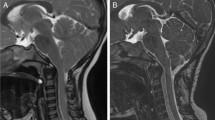Abstract
Background
Specific symptom outcomes after craniovertebral decompression for patients with Chiari type 1 malformation, without accompanying syringomyelia, are not well characterised and poorly reported.
Methods
We performed a retrospective review of all patients diagnosed with Chiari type 1, without syringomyelia, who underwent craniovertebral decompression in our unit.
Results
We identified 129 individuals with a minimum of 2 years’ follow-up. The most common pre-operative symptoms were pressure dissociation headaches (78%), visual disturbances (33%), dizziness/balance disturbances (24%) and blackouts (17%). The symptoms most likely to respond to surgery included Valsalva-induced headache (74% response, p < 0.0001) and blackouts (86% response, p < 0.001).
Conclusions
After successful craniovertebral decompression, most patients presenting with pressure dissociation headaches and blackouts will improve. However, the large variety of other symptoms patients often present with may not improve after surgery.


Similar content being viewed by others
Abbreviations
- CSF:
-
Cerebrospinal fluid
- CCOS:
-
Chicago Chiari Outcome Scale
References
Aliaga L, Hekman KE, Yassari R, Straus D, Luther G, Chen J, Sampat A, Frim D (2012) A novel scoring system for assessing Chiari malformation type I treatment outcomes. Neurosurgery 70(3):656–664 discussion 664-665
Giammattei L, Messerer M, Daniel RT, Aghakhani N, Parker F (2017) Long term outcome of surgical treatment of Chiari malformation without syringomyelia. J Neurosurg Sci. doi: 10.23736/S0390-5616.17.04063-2
Beretta E, Vetrano IG, Curone M, Chiapparini L, Furlanetto M, Bussone G, Valentini LG (2017) Chiari malformation-related headache: outcome after surgical treatment. Neurol Sci 38(Suppl 1):95–98
Rowlands A, Sgouros S, Williams B (2000) Ocular manifestations of hindbrain-related syringomyelia and outcome following craniovertebral decompression. Eye (Lond) 14(Pt 6):884–888
Goldschagg N, Feil K, Ihl F, Krafczyk S, Kunz M, Tonn JC, Strupp M, Peraud A (2017) Decompression in Chiari malformation: clinical, ocular motor, cerebellar, and vestibular outcome. Front Neurol 8:292
Wieshmann U, Meierkord H (1995) Cough syncope with hypertension-caused by brainstem compression? Eur J Neurol 2(5):498–500
Nogués M, Delorme R, Saadia D, Heidel K, Benarroch E (2001) Postural tachycardia syndrome in syringomyelia: response to fludrocortisone and beta-blockers. Clin Auton Res 11(4):265–267
Prilipko O, Dehdashti AR, Zaim S, Seeck M (2005) Orthostatic intolerance and syncope associated with Chiari type I malformation. J Neurol Neurosurg Psychiatry 76(7):1034–1036
Author information
Authors and Affiliations
Contributions
All authors contributed to the study conception and design. Material preparation, data collection and analysis were performed by Joshua Pepper and Ahmed Elhabal. The first draft of the manuscript was written by Joshua Pepper and all authors commented on or revised previous versions of the manuscript. All authors read and approved the final manuscript.
Corresponding author
Ethics declarations
Conflict of interest
The authors declare that they have no conflict of interest.
Ethical approval
For this type of study (retrospective study), formal consent is not required.
Additional information
Publisher’s note
Springer Nature remains neutral with regard to jurisdictional claims in published maps and institutional affiliations.
This article is part of the Topical Collection on CSF Circulation
Rights and permissions
About this article
Cite this article
Pepper, J., Elhabal, A., Tsermoulas, G. et al. Symptom outcome after craniovertebral decompression for Chiari type 1 malformation without syringomyelia. Acta Neurochir 163, 239–244 (2021). https://doi.org/10.1007/s00701-020-04631-z
Received:
Accepted:
Published:
Issue Date:
DOI: https://doi.org/10.1007/s00701-020-04631-z




